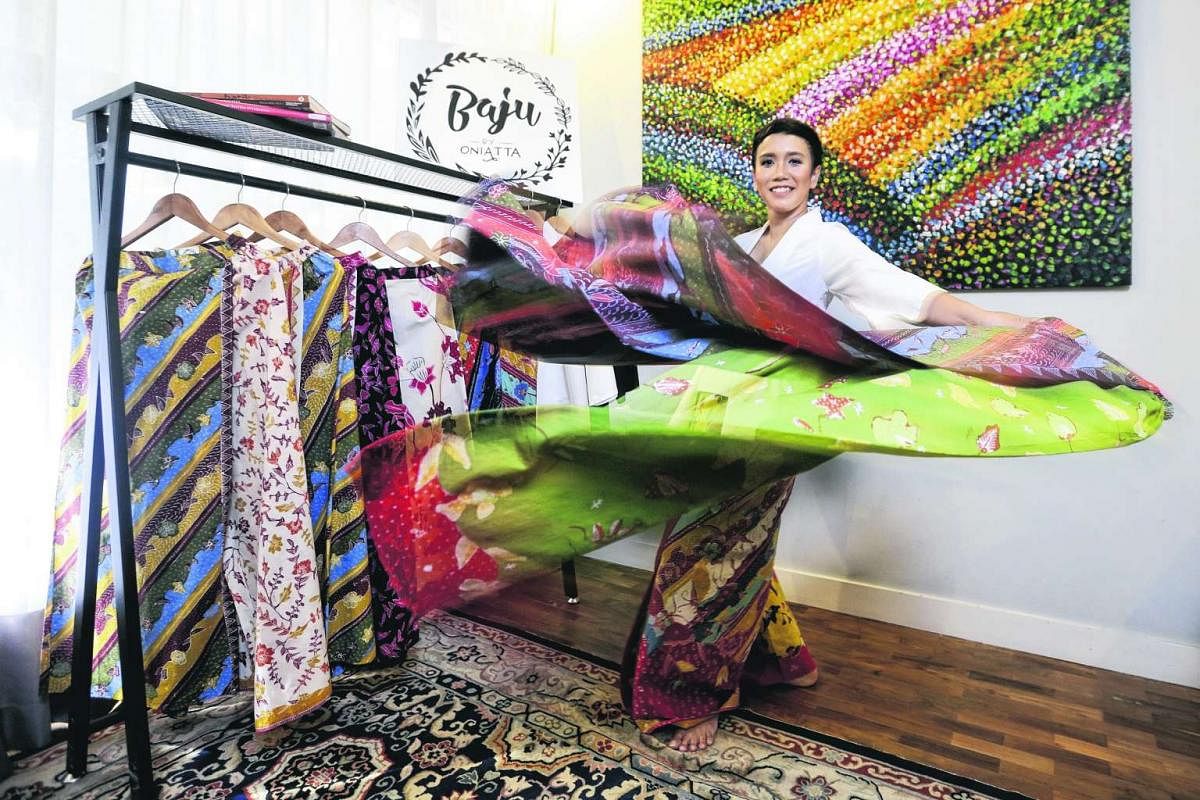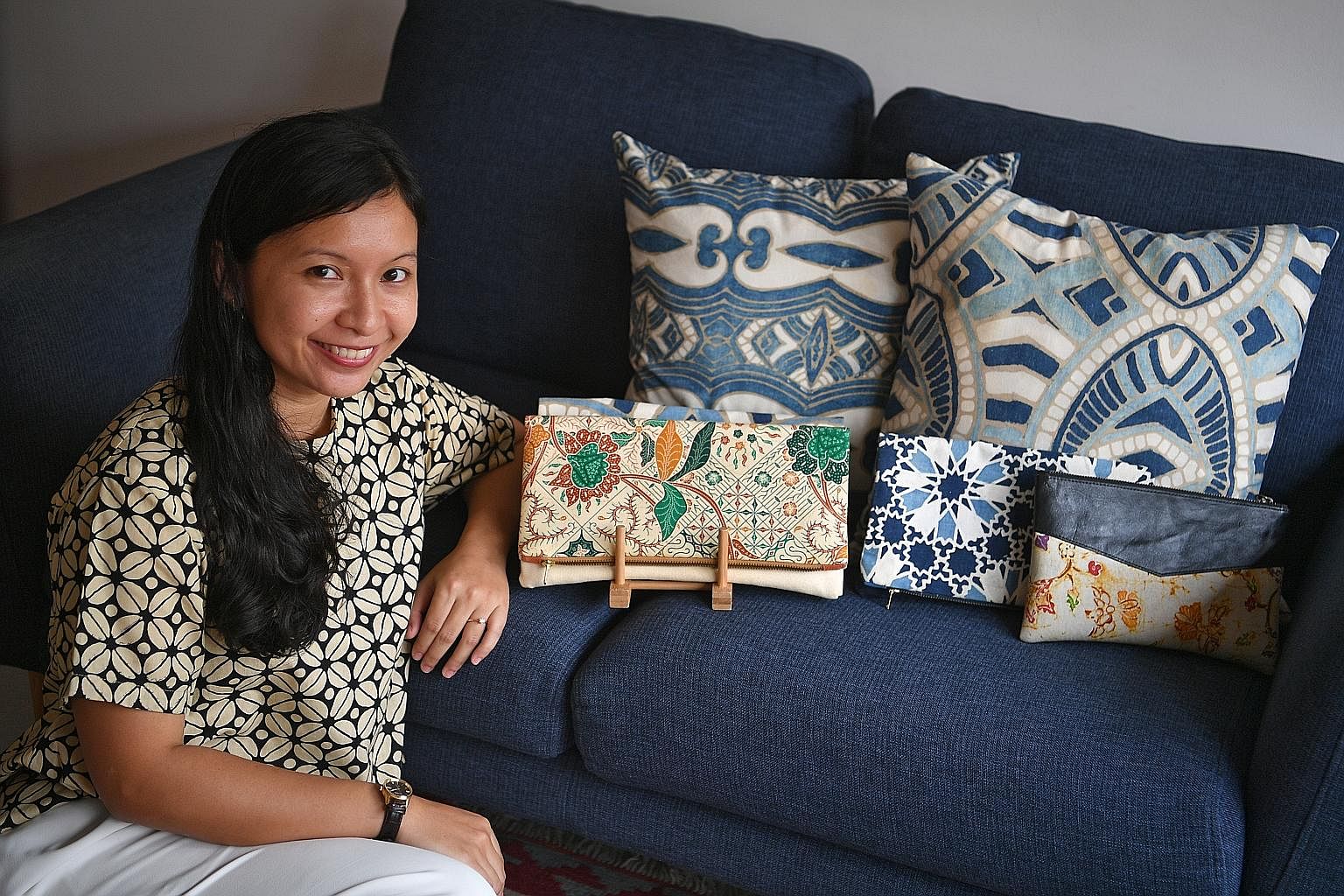-
Tips on caring for batik
-
Ms Nur Aqilah Zailan, 28, founder and designer of fashion accessories and home-decor label Gypsied, shares some tips on how to care for batik.
1 Hand wash and soak the batik in cold water with a mild soap, such as baby shampoo. Watch out for the colours, which may run. Unlike machine-printed fabric, batik is not colour-fast and will fade slightly with each wash. However, this adds to its beauty over time and lends the textile a vintage feel.
2 Batik cloth, which has not been made into products, should be preferably stored rolled-up, as folding may cause cracks in the wax-drawn patterns. However, if you must fold batik, open it up and air it once or twice a year to reduce the likelihood of cracking.
Alyssa Woo
Batik gets a revival as local independent designers give it a modern twist
More fashion labels are putting a modern twist on the traditional textile and incorporating it into their designs

Batik, which adorns kitschy trinkets and T-shirts at souvenir stores here, or brings to mind the famous Singapore Airlines air stewardess uniform, is getting a revival.
New independent local labels, such as womenswear label Baju by Oniatta and leather goods label Oakmoon Crafts, are offering something that big department stores here do not, weaving batik into their designs and giving the traditional method of wax-printing a modern twist.
The traditional textile is being paired with ever-trendy materials such as leather or used to make everyday work clothes.
Last month, contemporary fashion label Ong Shunmugam incorporated batik into its latest collection, Gadis Perkasa (Mighty Woman in English) - using the textile in her skirts and kebaya tops, mixed with lace.
Independent local bag and accessories label Girl With A Radio Mind uses batik - sourced from around Asia and as far away as Africa - to handmake bags and also uses them as centrepieces for accessories such as coin purses.
The designers source authentic, hand-drawn batik from villages in Indonesia and Africa. Some of the products are then manufactured in Indonesia or handmade by the designers themselves.
Batik, a technique which uses wax on fabric to create designs, can be found in different Asian countries, including Singapore and India, but the most sophisticated designs are found in Indonesia.
Patterns and motifs are hand-drawn or copper-stamped onto a rectangular piece of cotton or silk, typically 2m-long, using melted wax.
The cloth is then dyed and the design is revealed when the layer of hardened wax is removed after the dye has dried.
Depending on how complex the design is and how many colours are used, the process of applying wax and dyeing is repeated many times to achieve the final result.
Ms Oniatta Effendi, founder and designer of Baju by Oniatta, says that it takes about three to six months on average to produce batik.
She adds: "Batik with finer patterns may even take up to a year, but I have heard of artisans who now take up to two weeks for fairly simple ones. So it really depends on how complex the artwork is."
Designs vary by region and artist, but batik from Java, Indonesia, is broadly grouped into two categories: inland and coastal batik.
Inland batik, especially from Yogyakarta city in Java, is the oldest form of batik. It is typically dark, with colours, such as black, brown and dark blue, and tends to be geometric in design.
Coastal batik, which can be found in northern Java on islands and in port cities such as Madura and Cirebon, is a lot more colourful and vibrant, with floral and animal motifs.
It is coastal batik that Ms Oniatta, 43, prefers to use for her Utama pants - long pants that come with a front skirt-overlay.
For her latest collection, she used batik from Madura, an island off the north-eastern coast of Java, as she likes the "tastefully colourful" use of red, blue, green and yellow.
Shoppers such as Ms Noorshidah Ibrahim is surprised at the variety of batik on the market now.
The 42-year-old visual arts educator, who is currently pursuing a master's degree, says: "I started loving batik only recently, when I started seeing more modern and fresher ways of wearing it.
"I grew up seeing my late mother and grandmother wear batik, but the dull browns, ochre and beige tones put me off."
Teacher Ms Anna Ng, 49, who has been wearing batik since she was in her 30s, likens putting on batik to wearing art.
She also loves that no two pieces of handmade batik are the same.
"It's an art form that has been passed down for generations and I love the idea that I'm wearing a piece of history and art."
Motifs are symbols of hope and community

Each 40-piece collection of batik clutches designed by Ms Nur Aqilah Zailan takes less than a month to sell out.
Most of her customers are working women between 25 and 40 years old and many are repeat customers who buy her colourful fold-over or zippered batik clutches in hopes of passing them on to their daughters.
The 28-year-old says: "The surprising response I've been getting is that customers say they can keep it for their daughters, which intrigues me. I feel like that is what people are looking for in this day and age, to connect with something."
Ms Aqilah, who launched fashion accessory and home-decor label Gypsied in 2013, designs and releases a new collection of batik clutches every two months, with each collection having up to 40 clutches. Each is priced between $40 and $60.
The clutches make up about 80 per cent of the items she produces and are her bestsellers. She also makes batik cushions, headbands and necklaces. All items are sold at www.shopgypsied.com.
Ms Aqilah, who has a full-time job in the e-commerce industry, says that she was drawn to batik because of its ability "to be a form of expression through colours, patterns, meaning and its connection to Malay arts and culture".
The university graduate in business travels to Indonesia three times a year to source for the batik herself. She chooses textile from only fair-trade textile collectives that ensure artisans are paid a fair wage.
She says: "I think what makes batik so personal is that the motifs reflect Javanese philosophies of life and are symbols of hope and community which are still applicable today."
She highlights the sekar jagad (flowers of the universe) motif, a repeated flower pattern usually worn by brides and grooms to convey joy at having found each other, and the kawung motif, a four-lobed pattern inspired by the palm tree that signifies the wearer as being useful to his community.
As popular as her clutches are, Ms Aqilah keeps quantities low to control the quality.
She says: "Unlike machine- printed textiles, you cannot produce batik in bulk. If I do this, it's not possible to control the quality.
"This is a slow approach to fashion and the nature of the textile as batik is made by hand. You cannot produce them fast."
Ms Aqliah, who is married to a freelance photographer, initially made the products herself at home with a sewing machine, but started outsourcing production to Bali, Indonesia, in 2015, as she wanted to improve the quality of the sewing.
Coincidentally, choosing to work with batik has also made her feel closer to her paternal grandmother, who died before she was born.
She says: "Recently my father told me that although my grandmother was of Thai descent, she loved wearing the kebaya and batik sarong. I don't have any of her clothes, but I feel a sense of connection to my grandma through batik.
"In a way, I feel that a big part of my attraction to batik is about looking for identity and meaning through heritage."
Remembering the past
For Ms Oniatta Effendi, founder and designer of fashion label Baju by Oniatta, batik is more than just a fabric.
The 43-year-old, whose paternal and maternal grandparents are from Java in Indonesia, says she wears batik almost every day - she has numerous batik tops, dresses and pants - and that it serves as a reminder of her Indonesian heritage and culture.
Her favourite batik motif is the parang rusak. Meaning "broken knife" in English, the symbol was worn only by court officials and royalty and is widely associated with a 17th-century ruler in Central Java, Sultan Agung of Mataram.
Adds the mother of five: "It was seen as having symbolic royal power. I like to see myself being clothed by courage."
Her curiosity prompted her to explore the stories behind various motifs and she soon discovered the rich narrative of Indonesian culture behind each one.
Ms Oniatta highlights a particular batik motif that piqued her interest - an image of the mythical Garuda bird at first glance, but actually a woman's reproductive anatomy surrounded by swirling phallic symbols.
She says: "It's really intriguing and it's only natural to embrace the idea that if a person dons this to a wedding, the wearer brings with him or her blessings of hope and fertility to the couple."
Ms Oniatta, a drama teacher in a local polytechnic who is married to a lawyer, started her womenswear label last October. Her signature Utama pants design, long pants with a front-skirt overlay, is priced between $129 and $179. Her current collection combines two different batik prints.
She says with a laugh: "I'm a mother of five. I want to look like a beautiful Malay woman, but I still need to be able to chase my children around."
The majority of her customers are Singaporean women who love the pants as they find them quirky and versatile enough for formal occasions. The fabric is sourced from different cities in Indonesia, such as Cirebon, Yogyakarta and Pekalongan, and her designs are made by tailors in Jakarta.
Response to the label has been overwhelming, with some customers buying as many as six pairs of pants at a go, says Ms Oniatta. "I'm not producing enough to meet demand - taking into account the constraints of my full-time job."
She also makes dresses, kebaya tops and bespoke men's shirts. She operates the label from home and the designs will be sold at multilabel boutique En Pointe in North Bridge Road from Sunday.
Through her label, she hopes to educate shoppers on the history and culture of batik, so that it can be appreciated by many, as she feels that batik is "entrapped in a time capsule".
She says: "The association people have with batik usually has to do with women in P. Ramlee films, where they are clad in sarongs and sing along riverbanks; our mother's ragged house coats they continue to wear even with holes at the armpits; and the cloth that covers the deceased.
"I think we need to reinvent how it is worn and appreciated. Batik is more than just a piece of fabric. It has culture, a livelihood and a narrative of its own."
Singaporean fell in love with batik in Bali
When one buys a batik-lined wallet or bag from Mr Darshan Kadam's label, Oakmoon Crafts, they are indirectly supporting craftsmen from Java, Indonesia.
These craftsmen make batik by hand, a process that can take up to a year for complex designs.
The cloth is gathered by Indonesian batik artist Bu Dewi during her week-long expeditions to different regions in the country. She also makes her own versions at her home studio in Ubud, Bali.
It is from her that Mr Kadam, a Singaporean based in Bali, Indonesia, gets his batik.
The 26-year-old met Ms Dewi a year ago through a mutual friend as he was trying to source for affordable and authentic batik. The batik that Mr Kadam had seen at craft markets were either mass produced and cheap or too expensive.
Ms Dewi was happy to help.
He says: "By working with her, not only do I get to select from a vast variety of batik, but I also get to support her and the people she sources it from."
Oakmoon Crafts, which Mr Kadam launched online this February, has made-to-order leather goods, such as bags and wallets, combined with batik and a handwoven patterned textile called ikat tenun. About 70 per cent of what he makes are customised orders.
Mr Kadam, who was a student at Lasalle College of the Arts, chose to incorporate batik into his designs as he likes traditional motifs and thought it would make his leather products stand out.
He prefers batik with a simple motif and muted colours over those with a more complicated design. He says: "It might look fine as a sarong, but when I scale it down to fit my leather products, I think about whether the pattern is too big and if the scale of it is balanced."
Although the label's sales and customer base have been increasing, Mr Kadam says he needs to supplement his income with freelance design work.
He moved to Bali with his girlfriend about 11/2 years ago. He was then a second-year student studying graphic design at Lasalle College of the Arts.
He remembers feeling constantly "stuck" creatively and craved a change of scenery.
The couple stayed in Ubud for a few months before moving to Canggu, where they have been based for a year. His girlfriend, who is Indonesian, has a tarot card-reading business.
Although Mr Kadam first encountered batik in Singapore, he fell in love with it only when he came across more vibrant varieties in Bali.
"The T-shirts sold in Singapore use mainly inland batik and I didn't really like the earthy colours and its dense design," he says. "But when I moved to Bali, I was exposed to a much wider range of batik and I really like the vibrant and lively colours and patterns of coastal batik."
He adds: "I think batik is an undervalued art. To make batik, they have to hand-draw the design with wax before they dye it and they have to repeat the process for every colour.
"There's a lot of dedication in making it."
Fun, contemporary batik pieces
iPhone Flip Wallet, $85, from Oakmoon Crafts, www.oakmooncrafts.com

This phone flip case fits an iPhone 7 and is made of genuine leather. It is lined with batik and has three card slots and one money slot.
Utama pants, $179, from Baju by Oniatta, available from Sunday at En Pointe boutique at 735 North Bridge Road

These long pants with a front skirt-overlay are made with two different pieces of batik. Pair with a loose top for casual occasions or belt up with an obi sash to highlight your waist.
Puspa clutch, $41.90 (original price $55.90), Gypsied, www.shopgypsied.com

This clutch with a puspa print, meant to symbolise the jasmine flower, is dyed using natural dye. The 29.21 x 29.21cm foldover clutch is big enough to hold an iPad.
African Batik Orange Jute Purse, US$24 (S$33.80), Girl With A Radio Mind, www.girlwitharadiomind.etsy.com
This 14 x 9cm handmade purse has a front cotton flap featuring a geometric African motif and a braided hemp handle. It has two main compartments and another one at the back of the purse.
Join ST's Telegram channel and get the latest breaking news delivered to you.
A version of this article appeared in the print edition of The Straits Times on May 11, 2017, with the headline Batik gets a revival as local independent designers give it a modern twist. Subscribe

